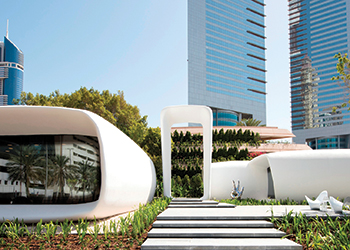
 Louvre Abu Dhabi ... a key milestone.
Louvre Abu Dhabi ... a key milestone.
Tourism Development & Investment Company (TDIC) has achieved a major milestone in the development of Louvre Abu Dhabi museum, with the removal of temporary sea protection walls at the project site on Saadiyat Island to allow the sea to surround the building.
With this move, the integration of the sea with the Louvre Abu Dhabi museum project, has begun, thus converting it into a ‘museum on the sea’. The process is taking place in three stages within the temporary earth platform, an area of reclaimed land sitting 4 m above sea level, from which all the construction work to date has been built.
The master developer of key tourism, cultural and residential destinations in Abu Dhabi, TDIC said these temporary sea protection walls were used during the main construction phase.
At the start of the project, a continuous hydraulic cut-off wall was constructed and pumps were installed to remove the water and allow excavation, piling and subsequent works to be undertaken in dry conditions.
TDIC, dubbing the integration of the sea with the Louvre Abu Dhabi museum as a significant milestone, said it was a key step towards realising the vision for this world-class cultural institution, by its famous architect Jean Nouvel, as a ‘museum city’ on the sea.
“This is a great milestone in the development of Louvre Abu Dhabi. This delicate process is the result of months of planning and preparation to ensure that the inflow of sea water takes place in a controlled manner around and within strategic places in the museum,” remarked Ali Majed Al Mansoori, the TDIC chairman.
The first stage of integrating the sea with the site involved the shutdown of selected pumps to allow the water level to rise slowly around the museum’s basements located below seabed level. During this process, the various shallow tidal pools which surround the Louvre Abu Dhabi were filled with sea water.
The second stage has also been completed, where the remaining pumps were shut down and sea water was pumped inside the temporary hydraulic cut-off wall. Continual inspections were carried out to ensure that no evidence of water ingress was detected within the basement structure, which is protected by a sophisticated re-injectable double membrane waterproof system.
The third and final stage, which commenced last month, involves further pumping of sea water within the temporary walls and around the Louvre Abu Dhabi, raising the water level to match the sea level. This will be followed by the removal of the hydraulic cut-off wall and the final construction of permanent marine sea defences which will complete the full integration of the sea with the Louvre Abu Dhabi.
To date, the project has witnessed the completion of the museum’s 180-m-diameter dome, which is made up of four outer stainless steel layers and four inner layers, supported by a steel structure 5 m in height, as well as the installation work of 30,000 sq m of natural stone paving and the completion of its basement levels.
Moreover, advanced work is currently under way on the main gallery spaces, entrance and administration buildings.
In addition, some 4,500 lights have also been installed to the dome’s steel structure, illuminating Louvre Abu Dhabi at night. This permanent feature is controlled by a lighting system which allows the adjustment of the level of brightness.
Louvre Abu Dhabi is part of the Saadiyat Cultural District and will become home to two more cultural institutions, Zayed National Museum and Guggenheim Abu Dhabi.





















_0001.jpg)


.jpg)
















.jpg)








.jpg)




